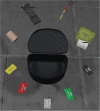First Responder Virtual Reality Simulator to train and assess emergency personnel for mass casualty response
- PMID: 36817080
- PMCID: PMC9933861
- DOI: 10.1002/emp2.12903
First Responder Virtual Reality Simulator to train and assess emergency personnel for mass casualty response
Abstract
As mass casualty incidents continue to escalate in the United States, we must improve frontline responder performance to increase the odds of victim survival. In this article, we describe the First Responder Virtual Reality Simulator, a high-fidelity, fully immersive, automated, programmable virtual reality (VR) simulation designed to train frontline responders to treat and triage victims of mass casualty incidents. First responder trainees don a wireless VR head-mounted display linked to a compatible desktop computer. Trainees see and hear autonomous, interactive victims who are programmed to simulate individuals with injuries consistent with an explosion in an underground space. Armed with a virtual medical kit, responders are tasked with triaging and treating the victims on the scene. The VR environment can be made more challenging by increasing the environmental chaos, adding patients, or increasing the acuity of patient injuries. The VR platform tracks and records their performance as they navigate the disaster scene. Output from the system provides feedback to participants on their performance. Eventually, we hope that the First Responder system will serve both as an effective replacement for expensive conventional training methods as well as a safe and efficient platform for research on current triage protocols.
Keywords: disaster planning; education; educational measurement; emergency medical services; professional competence; transportation of patients; triage.
© 2023 The Authors. JACEP Open published by Wiley Periodicals LLC on behalf of American College of Emergency Physicians.
Conflict of interest statement
The authors declare no conflict of interest.
Figures




Similar articles
-
Learner evaluation of an immersive virtual reality mass casualty incident simulator for triage training.BMC Digit Health. 2024;2(1):56. doi: 10.1186/s44247-024-00117-5. Epub 2024 Sep 16. BMC Digit Health. 2024. PMID: 39290871 Free PMC article.
-
Acceptability and applicability of using virtual reality for training mass casualty incidents- a mixed method study.BMC Med Educ. 2025 May 19;25(1):728. doi: 10.1186/s12909-025-07319-z. BMC Med Educ. 2025. PMID: 40389938 Free PMC article.
-
Exploring the role of virtual reality in preparing emergency responders for mass casualty incidents.Isr J Health Policy Res. 2025 Apr 9;14(1):22. doi: 10.1186/s13584-025-00681-9. Isr J Health Policy Res. 2025. PMID: 40205512 Free PMC article.
-
Virtual reality simulation training for health professions trainees in gastrointestinal endoscopy.Cochrane Database Syst Rev. 2018 Aug 17;8(8):CD008237. doi: 10.1002/14651858.CD008237.pub3. Cochrane Database Syst Rev. 2018. PMID: 30117156 Free PMC article.
-
Virtual Reality Training in Disaster Medicine: A Systematic Review of the Literature.Simul Healthc. 2023 Aug 1;18(4):255-261. doi: 10.1097/SIH.0000000000000675. Epub 2022 Jun 14. Simul Healthc. 2023. PMID: 35696131
Cited by
-
Implementation of a workshop for mass casualty incident triage training using an immersive virtual reality simulation.AEM Educ Train. 2024 May 20;8(Suppl 1):S70-S75. doi: 10.1002/aet2.10939. eCollection 2024 May. AEM Educ Train. 2024. PMID: 38774825 Free PMC article.
-
SALT triage training and virtual reality demonstration.J Am Coll Emerg Physicians Open. 2024 Jun 24;5(3):e13203. doi: 10.1002/emp2.13203. eCollection 2024 Jun. J Am Coll Emerg Physicians Open. 2024. PMID: 38919888 Free PMC article. No abstract available.
-
Evaluation of high-fidelity and virtual reality simulation platforms for assessing fourth-year medical students' encounters with patients in need of urgent or emergent care.Ann Med. 2024 Dec;56(1):2382947. doi: 10.1080/07853890.2024.2382947. Epub 2024 Jul 30. Ann Med. 2024. PMID: 39078334 Free PMC article.
-
A Low-Cost, Low-Tech Virtual Mass Casualty Training Simulation for Undergraduate Medical Education.Cureus. 2024 Sep 17;16(9):e69603. doi: 10.7759/cureus.69603. eCollection 2024 Sep. Cureus. 2024. PMID: 39429358 Free PMC article.
-
Learner evaluation of an immersive virtual reality mass casualty incident simulator for triage training.BMC Digit Health. 2024;2(1):56. doi: 10.1186/s44247-024-00117-5. Epub 2024 Sep 16. BMC Digit Health. 2024. PMID: 39290871 Free PMC article.
References
-
- Jones SG. Statement before the House Judiciary Subcommittee on Crime, Terrorism, and Homeland Security: The Evolution of Domestic Terrorism. Center for Strategic and International Studies. February 17, 2022. Accessed: May 17, 2022. https://www.jstor.org/stable/pdf/resrep39859.pdf
-
- Fortunato O, Dierenfeldt R, Basham S, et al. Examining the impact of the Obama and Trump candidacies on right‐wing domestic terrorism in the United States: a time‐series analysis. J Interpers Violence. 2022:37(23‐24):NP23397‐NP23418. - PubMed
-
- Aylwin CJ, König TC, Brennan NW, et al. Reduction in critical mortality in urban mass casualty incidents: analysis of triage, surge, and resource use after the London bombings on July 7, 2005. Lancet. 2006;368(9554):2219‐2225. - PubMed
-
- Landman A, Teich JM, Pruitt P, et al. The Boston marathon bombings mass casualty incident: one emergency department's information systems challenges and opportunities. Ann Emerg Med. 2015;66(1):51‐59. - PubMed
-
- Parrish GA, Bondani KJ, Bullard TB, et al. The Orlando nightclub shooting: firsthand accounts and lessons learned. MDEdge Emerg Med. 2016;48(8):348‐356.
Grants and funding
LinkOut - more resources
Full Text Sources
Research Materials
